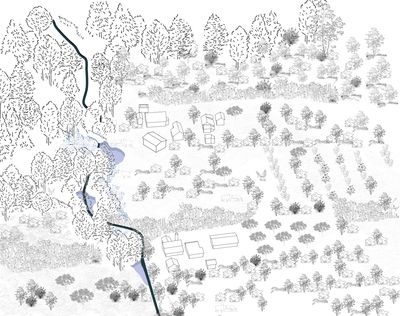Folding Agrarian Edges: A Vision for DübendorfAntonia Gerogianni and Diana Zarnescu
Where the city of Dübendorf ends, the landscape rapidly shifts from multifunctional high-rise and industrial buildings and large furniture stores to a neatly manicured agricultural belt. This belt is bound by both the city edge on one side and the protected edge of the forest, a sharply defined line at the edge of the monocultural fields. The abrupt edges at the limits of Zürich result from multiscalar processes of zoning and land protection measures that aim to mediate the distribution of land between three main land-use “forces”: food production, accommodation of a rapidly growing population and nature preservation.
The acceleration of land use change and the expansion of the Zürich Urban Agglomeration has led to the shrinking of agricultural land and a structural change in the farm size; Farms in Dübendorf have decreased in number from 177 in 1954 to 22 in 2024, while the average farm size has doubled throughout Switzerland. As a regulatory mechanism, zoning has delineated clear boundaries around the agricultural fields that are currently protected in a system of crop rotation areas known as Fruchtfolgeflächen, occasionally dissected by biodiversity protection zones and public leisure areas. In a context where substantial demographic changes and extensive densification of the urban fabric are foreseen, we ask whether the agricultural belt surrounding Dübendorf can become a mediating fabric that diffuses the edges of nature protection and settlement. What mechanisms can generate programmatic flexibilities between the land uses of Dübendorf?
Positioned at the fringe of Dübendorf city, we propose to read the agricultural belt as a transition area, potentially generating a new territorial coherence. The project aims to reconstruct exchanges between agriculture and the urban, expanding into the densely urbanised area of Dübendorf city and supporting the formation of “edible” public spaces. Agriculture then unfolds in a series of practices that start from the extension of the forest edge into a layer of fodder shrubs and rotational grazing, which weaves through the agricultural fabric and pushes back the city edge.
